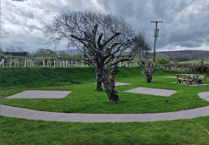One of Somerset’s most beautiful landscapes is gradually becoming easier to access and enjoy as part of a wider programme of conservation.
The Quantock Hills national landscape is the oldest area of outstanding natural beauty (AONB) in England, receiving this designation back in 1956.
The landscape has faced numerous challenges in recent years, ranging from increased demand for local housing to the impact of ash dieback and changes in visitor habits since the coronavirus pandemic.
But work to protect and improve the hills is under way from the Quantock Hills Landscape Partnership and its numerous partners, including new efforts to improve access and protect the hills’ unique range of flora and fauna.
England’s AONBs were re-designated as national landscapes by the government in late-2023 – a change which does not come with any additional funding or powers to prevent unwanted development, either within its borders or on its doorstep.
Numerous villages on the borders of the Quantocks have also seen significant new developments approved in recent memory, such as the Moorland Gate site in Bishop’s Lydeard and the Cricketer Farm site in Nether Stowey.
On top of traditional bricks-and-mortar housing growth, these communities have seen a rise in demand for temporary accommodation in the form of camp-sites or caravan parks, primarily geared for the growing workforce at the Hinkley Point C nuclear power station site.
Numerous campsites have been given permission to expand as a result of the ‘workforce uplift’ EDF Energy had agreed with the council, including the Quantock Lakes camp-site in Nether Stowey and the Moorhouse Farm site in Holford, near the northern tip of the hills.
On top of the economic challenges, the Quantocks have been hit badly in recent years by ash dieback (also known as chalara), a “highly destructive” disease caused by the fungus hyhmenoscyphus fraxineus, which originated in Asia. The fungus kills between 90 and 98 per cent of all trees which it infects, and there is no treatment for it.
Ash is a very important species, with their canopies allowing light to reach the woodland floor to encourage ground-based plants, and they provide a habitat for nearly 1,000 different species of animal and plant life.

As well as improving air quality, ash trees can be turned into “strong, durable, flexible and attractive” timber when they are cut down – with ash commonly being used to make door handles, furniture, flooring and sporting goods.
Without the timely intervention of the Quantock Hills Landscape Partnership, whole swathes of the hills could be devoid of any tree cover within a few decades.
To prevent this frightening future, the partnership has been working with local landowners, Somerset Council and the Forestry Commission to remove diseased trees and plant other species in their place, especially at the southern end of the hills near the villages of Broomfield and Cothelstone.
This will complement other initiatives identified in the Quantock Hills nature strategy, published in April, which seeks to protect and enhance the native populations within the Quantocks, including adders, redstarts, slow-worms and yellowhammers
Iain Porter, the Quantock Hills Landscape Partnership project manager, stated in late-2020: “This is to increase the resilience of that woodland in the event of significant ash tree death.
“This will complement the existing support supplied by the Forestry Commission through their woodland advisers.
“We can provide signposting to existing support and where possible sourcing grant aid for farmers to under-plant where appropriate.”
The Quantock Hills have long been a popular visitor attraction, with its natural beauty being rivalled only by their cultural heritage.
Alfoxton House in Holford (which is now a Buddhist retreat centre) served as the home of William Wordsworth and his sister Dorothy at the end of the 18th century. Samuel Taylor Coleridge lived in Nether Stowey for a brief time, during which time he composed The Rime of the Ancient Mariner and began work on Kubla Khan.
Spy novelist John le Carré chose the Quantocks for the opening of Tinker, Tailor, Soldier, Spy, while Bryan Adams shot the video for his number one hit ‘Everything I Do (I Do It For You)’ (from Robin Hood: Prince of Thieves) in Holford and Kilve.
The hills have been referenced in everything from Doctor Who to Peep Show, and during the pandemic the likes of Cothelstone Hill and Dead Woman’s Ditch saw increasing numbers of visitors as the nation rediscovered the importance of fresh air and having green open space on one’s doorstep.
In response to this, the partnership has been working with Defra since December 2022 on its ‘removing barriers’ projects, undertaking more than £68,000 of capital improvements to make it easier for locals and visitors alike to experience the hills without damaging the landscape.
Somerset Council approved plans in May to improve the path leading up to Cothelstone Hill from its car park, adding new benches on one of the side routes to provide safe places where people could sit and admire the view before viewing the Seven Sisters beech trees at the summit.
Looking further ahead, the partnership is in the later stages of a £2.6m five-year scheme to look after the landscape within the Quantocks and the neighbouring parishes.
The scheme is funded largely by the National Lottery Heritage, with contributions from EDF Energy through the Hinkley Point C planning agreements, the National Trust and the Friends of the Quantocks
A spokesman said: “We have 23 individual projects, ranging from grants for restoring hedgerows, historic features, and traditional orchards through to educational work with local schools, archaeological excavations, archival research, and a wide ranging and inclusive events programme.
“The scheme aims to protect and restore the distinctive features of the Quantock landscape, improve management of the access pressures on the hills, and make the health and well-being benefits of recreation more available to communities in the surrounding towns and villages.”
To find out more about the Quantock Hills, including events taking place in your local area and how to get involved in conservation efforts, visit www.quantockhills.com.
-The-Alfoxton-Park-Trust-160321.jpg?width=752&height=500&crop=752:500)




Comments
This article has no comments yet. Be the first to leave a comment.